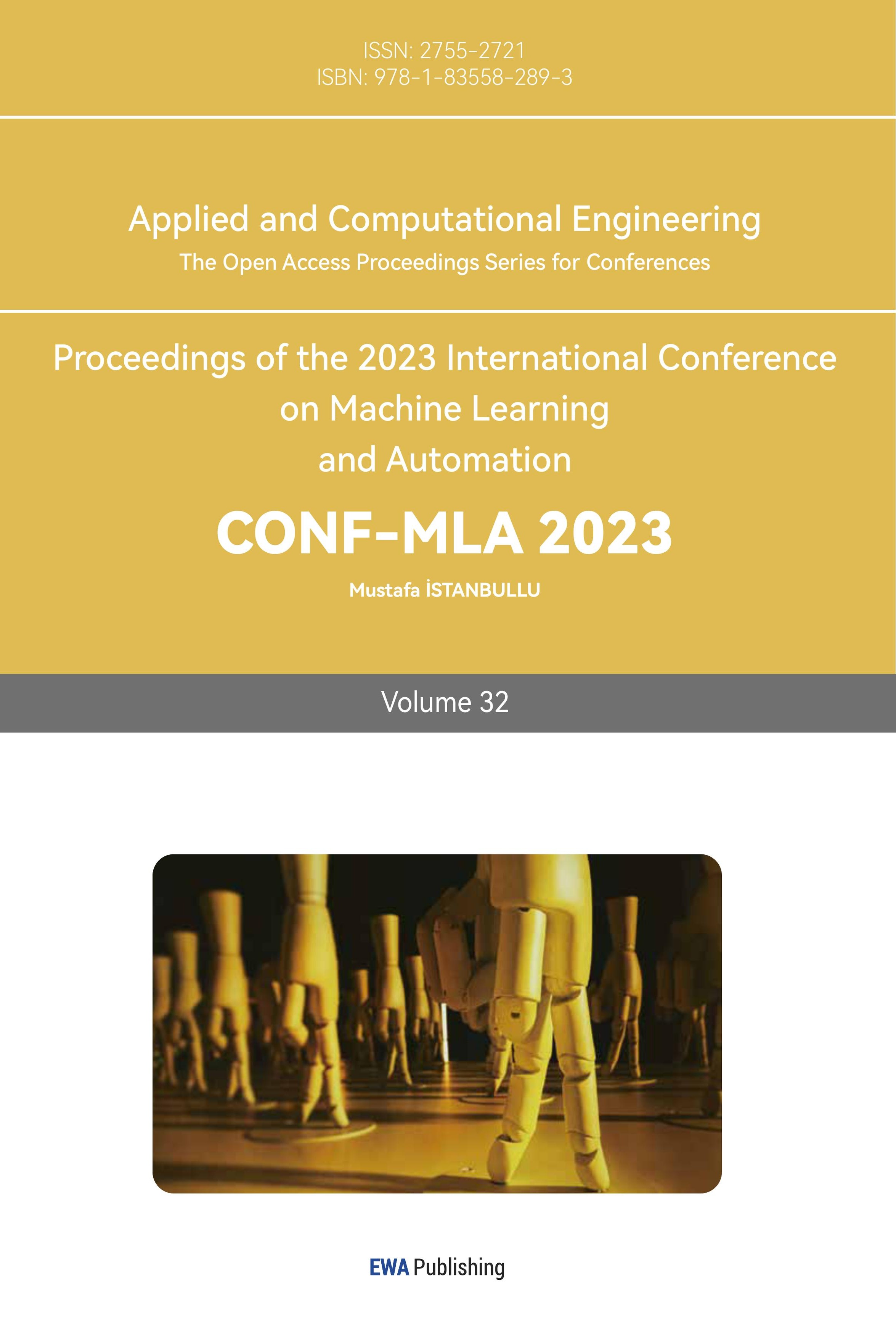References
[1]. Sanni-Anibire M O, Zin R M, Olatunji S O. Developing a preliminary cost estimation model for tall buildings based on machine learning[M]//Big Data and Information Theory. Routledge, 2022: 94-102.
[2]. Canese L, Cardarilli G C, Di Nunzio L, et al. Multi-agent reinforcement learning: A review of challenges and applications[J]. Applied Sciences, 2021, 11(11): 4948.
[3]. Sarker I H. Machine learning: Algorithms, real-world applications and research directions[J]. SN computer science, 2021, 2(3): 160.
[4]. Li Y. Research and application of deep learning in image recognition[C]//2022 IEEE 2nd International Conference on Power, Electronics and Computer Applications (ICPECA). IEEE, 2022: 994-999.
[5]. Sun Q, Ge Z. A survey on deep learning for data-driven soft sensors[J]. IEEE Transactions on Industrial Informatics, 2021, 17(9): 5853-5866.
[6]. Wang P, Fan E, Wang P. Comparative analysis of image classification algorithms based on traditional machine learning and deep learning[J]. Pattern Recognition Letters, 2021, 141: 61-67.
[7]. Ginart A A, Naumov M, Mudigere D, et al. Mixed dimension embeddings with application to memory-efficient recommendation systems[C]//2021 IEEE International Symposium on Information Theory (ISIT). IEEE, 2021: 2786-2791.
[8]. Zhang W, Li H, Li Y, et al. Application of deep learning algorithms in geotechnical engineering: a short critical review[J]. Artificial Intelligence Review, 2021: 1-41.
[9]. Jia W, Sun M, Lian J, et al. Feature dimensionality reduction: a review[J]. Complex & Intelligent Systems, 2022, 8(3): 2663-2693.
[10]. Zhang Y, Shi X, Zhang H, et al. Review on deep learning applications in frequency analysis and control of modern power system[J]. International Journal of Electrical Power & Energy Systems, 2022, 136: 107744.
Cite this article
Wang,P.;Xiao,K.;Zhou,L. (2024). Research on feature coding theory and typical application analysis in machine learning algorithms. Applied and Computational Engineering,32,85-92.
Data availability
The datasets used and/or analyzed during the current study will be available from the authors upon reasonable request.
Disclaimer/Publisher's Note
The statements, opinions and data contained in all publications are solely those of the individual author(s) and contributor(s) and not of EWA Publishing and/or the editor(s). EWA Publishing and/or the editor(s) disclaim responsibility for any injury to people or property resulting from any ideas, methods, instructions or products referred to in the content.
About volume
Volume title: Proceedings of the 2023 International Conference on Machine Learning and Automation
© 2024 by the author(s). Licensee EWA Publishing, Oxford, UK. This article is an open access article distributed under the terms and
conditions of the Creative Commons Attribution (CC BY) license. Authors who
publish this series agree to the following terms:
1. Authors retain copyright and grant the series right of first publication with the work simultaneously licensed under a Creative Commons
Attribution License that allows others to share the work with an acknowledgment of the work's authorship and initial publication in this
series.
2. Authors are able to enter into separate, additional contractual arrangements for the non-exclusive distribution of the series's published
version of the work (e.g., post it to an institutional repository or publish it in a book), with an acknowledgment of its initial
publication in this series.
3. Authors are permitted and encouraged to post their work online (e.g., in institutional repositories or on their website) prior to and
during the submission process, as it can lead to productive exchanges, as well as earlier and greater citation of published work (See
Open access policy for details).
References
[1]. Sanni-Anibire M O, Zin R M, Olatunji S O. Developing a preliminary cost estimation model for tall buildings based on machine learning[M]//Big Data and Information Theory. Routledge, 2022: 94-102.
[2]. Canese L, Cardarilli G C, Di Nunzio L, et al. Multi-agent reinforcement learning: A review of challenges and applications[J]. Applied Sciences, 2021, 11(11): 4948.
[3]. Sarker I H. Machine learning: Algorithms, real-world applications and research directions[J]. SN computer science, 2021, 2(3): 160.
[4]. Li Y. Research and application of deep learning in image recognition[C]//2022 IEEE 2nd International Conference on Power, Electronics and Computer Applications (ICPECA). IEEE, 2022: 994-999.
[5]. Sun Q, Ge Z. A survey on deep learning for data-driven soft sensors[J]. IEEE Transactions on Industrial Informatics, 2021, 17(9): 5853-5866.
[6]. Wang P, Fan E, Wang P. Comparative analysis of image classification algorithms based on traditional machine learning and deep learning[J]. Pattern Recognition Letters, 2021, 141: 61-67.
[7]. Ginart A A, Naumov M, Mudigere D, et al. Mixed dimension embeddings with application to memory-efficient recommendation systems[C]//2021 IEEE International Symposium on Information Theory (ISIT). IEEE, 2021: 2786-2791.
[8]. Zhang W, Li H, Li Y, et al. Application of deep learning algorithms in geotechnical engineering: a short critical review[J]. Artificial Intelligence Review, 2021: 1-41.
[9]. Jia W, Sun M, Lian J, et al. Feature dimensionality reduction: a review[J]. Complex & Intelligent Systems, 2022, 8(3): 2663-2693.
[10]. Zhang Y, Shi X, Zhang H, et al. Review on deep learning applications in frequency analysis and control of modern power system[J]. International Journal of Electrical Power & Energy Systems, 2022, 136: 107744.









